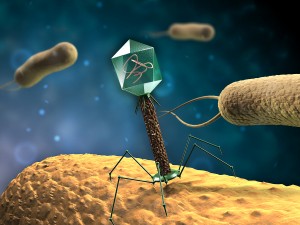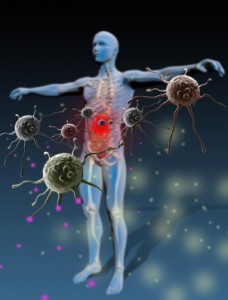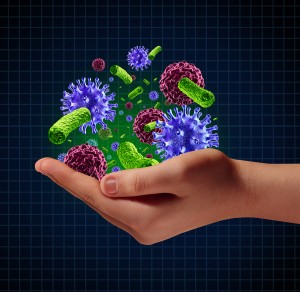 Many of the previous posts in Searching for the Mind have documented the cognitive abilities of cells, microbes, even viruses and perhaps jumping genes and prions. It is reasonable to consider that this active cognitive ability in cells influences evolution. Other posts have noted that in all animals, including humans, there are ten times as many microbes, and hundred times more viruses than the total number of cells in the animal—all with their own DNA. Therefore, if you consider the DNA from the microbes, human beings, actually, have 3 million genes not 24 thousand.
Many of the previous posts in Searching for the Mind have documented the cognitive abilities of cells, microbes, even viruses and perhaps jumping genes and prions. It is reasonable to consider that this active cognitive ability in cells influences evolution. Other posts have noted that in all animals, including humans, there are ten times as many microbes, and hundred times more viruses than the total number of cells in the animal—all with their own DNA. Therefore, if you consider the DNA from the microbes, human beings, actually, have 3 million genes not 24 thousand.
Several posts have described recent research about the influence of active microbe DNA secreting factors that influence the brain, including GABA, serotonin, dopamine, acetylcholine and norepinephrine. Microbes also stimulate BDNF, a critical brain factor in making new neurons; microbe stimulation of BDNF is critical for normal fetal brain development. Active microbe DNA is known to be critical for human digestion, vitamins, boosting or decreasing immune function, altering weight, and affecting stress. Therefore, microbe DNA must be included in any theory of evolution.
William B Miller, Jr. M.D., a physician for 30 years, has written an excellent and profound book, The Microcosm Within: Evolution and Extinction in the Hologenome. The book demonstrates how cognitive 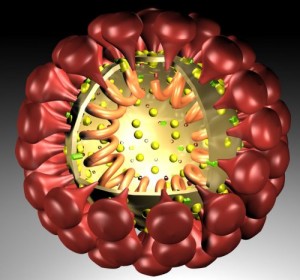 abilities of cells and extensive active microbe DNA inside other organisms are, in fact, the critical drivers of evolution. The hologenome is his term for the totality of all cells and microbes within any organism.
abilities of cells and extensive active microbe DNA inside other organisms are, in fact, the critical drivers of evolution. The hologenome is his term for the totality of all cells and microbes within any organism.
The book brilliantly incorporates disparate aspects of this essential but extremely complex process—the most elemental forces are the relentless, offensive and defensive, search by isolated genetic material for its best environment; and the cognitive abilities in all cells while competing, communicating and cooperating. It goes on to discuss mechanisms for cellular differentiation, pleuripotent cells, speciation, sexual reproduction and extinctions. Dr. Miller makes the very important observation that immune processes utilized by cells and microbes, as part of their communication, are a major driver of evolution.
Although not all the concepts in the book are simple, Dr. Miller makes this complex topic and his theory very clear; in addition, the book is very well written and illuminating for anyone in biology or general science.
The following is a Q and A with William Miller about his new Book on the Microcosm and Evolution — the hologenome and the microcosm within.
Question: You are a radiologist, how did you get interested in this?
Answer
I was a radiologist specializing in MRI and also doing a fair amount of interventional radiology. I was doing both academic and clinical practice for many years. While very interested in biological structures as a radiologist, visits to natural museums sparked my  interest in how evolution could have occurred. I remember visiting both the Field Museum of Natural History in Chicago, and the American Museum of Natural History in New York and noticed that bones of dinosaur fossils, if scale were allowed, are analogous in important ways to our own basic human anatomy. For example, there are many similarities between the humerus of a dinosaur and that of a human—or a femur, pelvis or vertebrae. But it was the singular disproportion of the puny arms of the tyrannosaurus Rex, named Sue, compared to its massive body size, that precipitated my search for new answers to the puzzle of evolutionary development. To adequately account this, something other than natural selection needed to be identified. From my medical background I wondered about the dynamics of evolutionary development, complexity, and speciation based on the primacy of immunological factors in our biologic world.
interest in how evolution could have occurred. I remember visiting both the Field Museum of Natural History in Chicago, and the American Museum of Natural History in New York and noticed that bones of dinosaur fossils, if scale were allowed, are analogous in important ways to our own basic human anatomy. For example, there are many similarities between the humerus of a dinosaur and that of a human—or a femur, pelvis or vertebrae. But it was the singular disproportion of the puny arms of the tyrannosaurus Rex, named Sue, compared to its massive body size, that precipitated my search for new answers to the puzzle of evolutionary development. To adequately account this, something other than natural selection needed to be identified. From my medical background I wondered about the dynamics of evolutionary development, complexity, and speciation based on the primacy of immunological factors in our biologic world.
Question: What is the hologenome concept? Are you saying that in any creature, all of the DNA, including those from all the microbes, must be considered as part of the genome?
Answer
The concept of the hologenome changes our basic understanding of complex organisms. When anyone looks into a mirror, they naturally see what they assume to be a single being. But, nature views us very differently. Rather than singular entities, we are in fact an incredibly complex network of collaborative, cooperative and 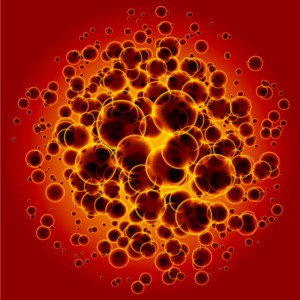 competitive cellular ecologies composed of our innate cells and almost incalculably numerous microbial inhabitants. These environments are so seamlessly linked together that we just feel as if we are just one being. We do not merely coexist with this additional life. This microcosm within and on us is essential to our well-being.
competitive cellular ecologies composed of our innate cells and almost incalculably numerous microbial inhabitants. These environments are so seamlessly linked together that we just feel as if we are just one being. We do not merely coexist with this additional life. This microcosm within and on us is essential to our well-being.
The collaboration of all the microbes and cells is so extensive that the volume of microbial cells associated with us outnumbers our innate cells by a factor of 10 to 1. The amount of that microbial genetic material overwhelms our intrinsic cellular DNA by a factor of 100 to 1.
The hologenome is the term that recognizes this new understanding since it applies to all complex creatures recognizing that any organism can only be properly understood by incorporating the totality of the DNA that makes that organism what it is. This comprises all the cellular and microbial life that awards it daily survival. Every species is really a cooperative venture of coexisting life in unique patterns of linked, co-dependent innate cellular and microbial ecologies. It is not that only some creatures are hologenomes. Every complex creature is, and there are no exceptions. That is the real biological terminus of evolutionary development on our planet.
Question: What does this mean for evolutionary theory?
Answer
Evolution theory has to change to accommodate this new appraisal of an organism. For a long time, there has only been two alternatives in evolutionary thinking; Darwinism based on the primacy of natural selection in evolution or Creationism which rejects evolution altogether. Hologenomic evolutionary theory provides a unique third path that is the first complete and coherent alternative to Darwinism.
Question: What are the primary tenets of Darwinian evolutionary theory?
Answer
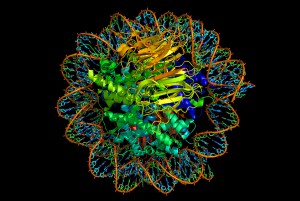 In Darwinian terms, evolution is propelled by the primary force of natural selection. To the greatest measure, reproductive rights are granted to the most fit at any moment of time. It is a narrative based on the survival of the fittest in a macroscopic framework. The Modern Synthesis or Neo Darwinism incorporates the genetic revolution within Darwinism viewing variation as the result of random genetic occurrences. Natural selection obviously acts on individual organisms but is only properly understood in the context of populations. In Darwinism, evolutionary change is necessarily a gradual process.
In Darwinian terms, evolution is propelled by the primary force of natural selection. To the greatest measure, reproductive rights are granted to the most fit at any moment of time. It is a narrative based on the survival of the fittest in a macroscopic framework. The Modern Synthesis or Neo Darwinism incorporates the genetic revolution within Darwinism viewing variation as the result of random genetic occurrences. Natural selection obviously acts on individual organisms but is only properly understood in the context of populations. In Darwinism, evolutionary change is necessarily a gradual process.
Question: What is wrong with Darwinism?
Answer
The major deficiency is what is considered the central paradox for Darwinian evolution based on natural selection. How does a mutation in a single individual ever become fixed in a population?
It is known from our own observations and from thousands of years of domestic breeding that permanent fixation of any variant or mutation in a species does not 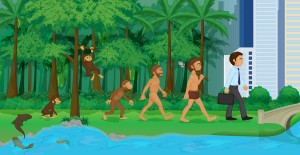 occur simply by breeding. For example in dogs, there is no evidence of speciation despite the particular interventions of man over thousands of years. In order to accommodate this fact within their theory, Darwinists have concentrated on proposing various means of achieving prolonged periods of sexual isolation for populations, for example by physical barriers or differential mating patterns. Despite the reality of our own observations, in a Darwinian framework, any apparent contradictions between that observation and theory are simply overcome by the weight of time. Interestingly, it is not generally realized that Darwin never indicated what actually causes speciation in his celebrated, On the Origin of Species. His work was about how populations evolve due to natural selection. His assumption, also, was that speciation would simply occur through variation given enough time.
occur simply by breeding. For example in dogs, there is no evidence of speciation despite the particular interventions of man over thousands of years. In order to accommodate this fact within their theory, Darwinists have concentrated on proposing various means of achieving prolonged periods of sexual isolation for populations, for example by physical barriers or differential mating patterns. Despite the reality of our own observations, in a Darwinian framework, any apparent contradictions between that observation and theory are simply overcome by the weight of time. Interestingly, it is not generally realized that Darwin never indicated what actually causes speciation in his celebrated, On the Origin of Species. His work was about how populations evolve due to natural selection. His assumption, also, was that speciation would simply occur through variation given enough time.
Question: What are the major differences between your theory and standard neoDarwinism?
Answer
Nearly every aspect of our understanding of our evolutionary narrative must be changed.
My theory has a very different starting place.
 Awareness exists within every living thing at every level and at every scale, even down to each cell or any living particle. Current research has unexpectedly revealed that all cells and microbes have elemental cognition and a previously unappreciated capacity for discrimination and preference. Physicians actually see this all the time in their practice in the predictable patterns of infectious disease, but little thought has been given to it. Yet, medical diagnosis is absolutely dependent on that fact. However, evolution, too, is experienced as a result of this natural cellular cognition.
Awareness exists within every living thing at every level and at every scale, even down to each cell or any living particle. Current research has unexpectedly revealed that all cells and microbes have elemental cognition and a previously unappreciated capacity for discrimination and preference. Physicians actually see this all the time in their practice in the predictable patterns of infectious disease, but little thought has been given to it. Yet, medical diagnosis is absolutely dependent on that fact. However, evolution, too, is experienced as a result of this natural cellular cognition.- Cellular awareness is a single unifying impulse that underlies all biology. Every cell of every kind and at every scale has awareness and seeks its own preferred status. It does this by trying to be in connection and communication with other cells. Infectious disease, symbiosis, parasitism, mutualism, biological and genetic latency, evolution and extinction all are expressions of this same crucial impulse differing only in amplitude, extent, and targets of opportunity based on varied immunological circumstances.
- Because of this, evolution proceeds by a different dynamic than simply by natural selection. Instead, it is based on genetic transfer, cellular intentionality and natural genetic engineering. The transfer mechanisms are not haphazard but proceed along the lines of
 biologic interactions that we have previously recognized as infectious disease dynamics. Natural selection still operates, only on a different scale than previously considered. It grants reproductive rights to the ‘fit enough to survive’ but is not the origin of species.
biologic interactions that we have previously recognized as infectious disease dynamics. Natural selection still operates, only on a different scale than previously considered. It grants reproductive rights to the ‘fit enough to survive’ but is not the origin of species. - Hologenomic evolution recognizes a new shaping force in evolutionary development and speciation. Immunology, not natural selection, rules in evolution, speciation, and extinction. The development and survival of all hologenomes are governed by immunological interplay. Inescapably then, immunology and the world of the small are the central actors in evolution rather than natural selection.
- As a result, a new biologic end point is reached. All complex creatures are hologenomes as vast collaborative networks of interlinked, co-dependent, and competitive cellular and microbial ecologies.
Question: What about survival of the fittest versus cooperation?
Answer
Evolution is centered on collaboration not just competition.
Nature is interested in collaborative relationships at every scale, not genes.  Evolution is about connections, not just competition for survival. Since all complex creatures are hologenomes, and there are no exceptions, evolution has inescapably progressed in such a manner as to to enable that collaboration. The concept of evolution as Darwinian competition is fit for the Victorian era but not for contemporary science. Hologenomic evolution instead concentrates on cellular cooperation towards mutual goals and consensual cellular outcomes as much or more than competition.
Evolution is about connections, not just competition for survival. Since all complex creatures are hologenomes, and there are no exceptions, evolution has inescapably progressed in such a manner as to to enable that collaboration. The concept of evolution as Darwinian competition is fit for the Victorian era but not for contemporary science. Hologenomic evolution instead concentrates on cellular cooperation towards mutual goals and consensual cellular outcomes as much or more than competition.
Question: What about increasing complexity?
Answer
Complexity is an act of creativity.
Complexity comes from innate cellular awareness. Natural genetic engineering as an  expression of that awareness is thus a form of of biologic creativity. Therefore, evolution is not primarily random as is explicitly believed by Darwinists but is the result of both limited, discrete cellular intentionality and random occurrences. When cells have awareness and discrimination, even at their own scale, and no matter how proscribed, non random choices can be made. This then drives evolution and complexity. Cells can cooperate to engineer preferred environments according to their own needs and reproductive requirements. When organism are re-envisioned as nearly illimitable co-linking environmental ecologies rather than singularities, the drive towards complexity is made coherent.
expression of that awareness is thus a form of of biologic creativity. Therefore, evolution is not primarily random as is explicitly believed by Darwinists but is the result of both limited, discrete cellular intentionality and random occurrences. When cells have awareness and discrimination, even at their own scale, and no matter how proscribed, non random choices can be made. This then drives evolution and complexity. Cells can cooperate to engineer preferred environments according to their own needs and reproductive requirements. When organism are re-envisioned as nearly illimitable co-linking environmental ecologies rather than singularities, the drive towards complexity is made coherent.
Question: What is the place of genes in evolution?
Answer
Genes serve.
It has been believed that genes exist to make forms. Instead, genes exist to serve forms, that is, to serve localized ecologies. Genes do not exist just to make an organism as has been believed They exist to serve all of the linked networked ecologies that make an organism and to enable their faithful reproduction according to the needs of the cellular constituents. And genes themselves have their own ecological construct and awareness.
Question: How do evolutionary changes occur – fast or slow?
Answer
Any evolutionary tempo will do.
The tempo of evolution can be fast or slow, and need not be the infinitesimally gradual process that Darwin believed necessary. Evolution relates to immunological interactions based on infectious disease dynamics and has no regular pace. It can act with immediacy and in bursts of evolutionary novelty or by creep.
Question: Why has this theory eluded so many scientists?
Answer
Most importantly, modern evolution theory needs to be based on the ‘unseen’, not the ‘seen’.
Evolution is all about the hidden capacities of cells and the immunological reactions that govern their world. Hologenomic evolutionary theory is based on connections centered in the ‘unseen’ rather than the ‘seen’ biological world.
Question:
Why should we care about this new information? Why is it so important for us now?
Answer
There are a number of very important implications.
- It is important that we understood what we really are — holobionts –as cooperative enterprises and not as exclusive organic singularities. It is only through this new perception that we can grasp our place as humans on earth. In turn, this knowledge will affect how we apprehend other creatures, how we value them and how we ethically treat them.
- Science is never settled. New ideas must be continually examined and embraced as a prelude to the next ‘better’ truth. Evolutionary biology is at that moment.
- Medicine needs to increasingly concentrate its therapies on hologenomic medicine that accounts for the full and actual range of interactions between the microbial life that is part of us and our health. This has far reaching implications for the treatment of infectious disease and will lead to new therapies for chronic diseases such as obesity, diabetes, depression, arthritic and immune disorders.
- The entire risks of genetic therapies are underestimated since the basic structure of complex organisms and the reasons for evolutionary development are critically misunderstood. Similarly, the risks of the de-extinction movement are unknown at this time with the possibility of many unanticipated risks from zoonoses ( the transmision of diseases from animals to humans and back.) A more thorough understanding of infectious pathogenesis in the
 hologenome and the ramifications of hologenomic evolution should be in place before de-extinctions are undertaken.
hologenome and the ramifications of hologenomic evolution should be in place before de-extinctions are undertaken. - Climate change has concentrated on the obvious ‘seen’ aspects of rising sea levels or melting polar ice. The more critical narrative for climate change, whenever it occurs or by any means, will be most importantly felt in a changing distribution and incidence of infectious disease. This issue has received scant notice with little attention to the changing distribution of West Nile virus in the U.S. or shifting patterns of malaria incidence in Africa.
Question:
As a takeaway, can you briefly summarize what is Hologenomic Evolutionary Theory?
Answer
All genetic material and all cells are sentient with awareness at their own scale and capable of preference at their cellular level.
All microbes and cells can cooperate as well as compete according to their needs yielding collective activities to sustain themselves in preferred environments.
They accomplish this through natural genetic and cellular engineering enabling the various cellular constituents to create hospitable local environments and ecologies. These link together and connect through collaboration, cooperation, and competition. Holobionts as hologenomes are that product.
Genetic transfer, cellular intentionality and natural genetic engineering are the means by which evolution unfurls.
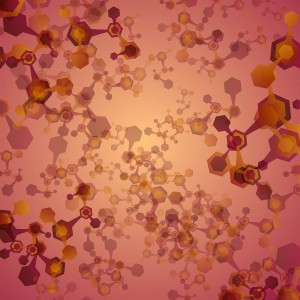 Genetic transfer mechanisms are not haphazard but proceed along the lines of biologic interactions that have traditionally viewed only as infectious disease dynamics.
Genetic transfer mechanisms are not haphazard but proceed along the lines of biologic interactions that have traditionally viewed only as infectious disease dynamics.
Immunological factors, not Darwinian natural selection, govern evolution, complexity, and speciation, and most extinctions.
Q and A with William Miller about his new Book on the Microcosm and Evolution
